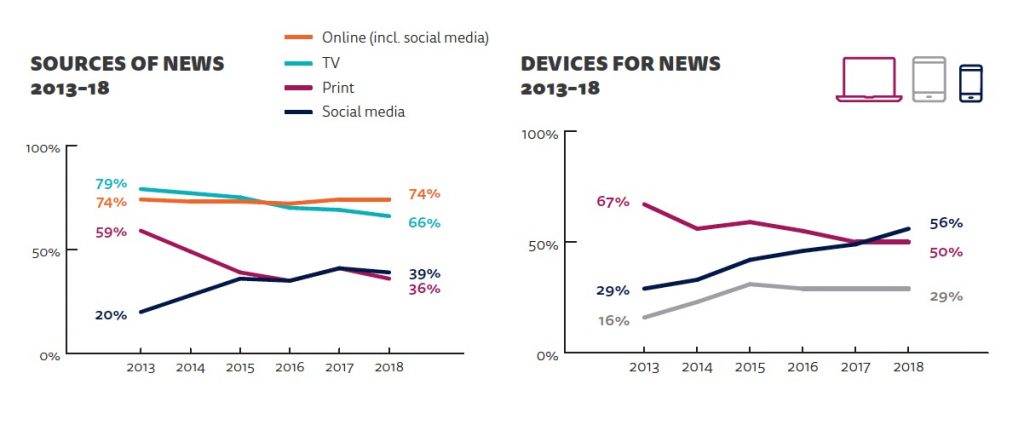The annual Digital News Report by the Reuters Institute for the study of journalism (RISJ) is a comprehensive look at trends in online news across the world. Whilst news itself is a specific discipline, I have found that people’s behaviour in consuming digital news content provides clues for future trends that will affect all media businesses. To save you reading the full 144 page report, these are my main insights for specialist publishers planning their digital strategy.
1. Content discovery is evolving
While social media remains an important gateway to news stories, the recent Facebook algorithm changes mean that platform’s relative importance is declining, as other social networks grow, and search sees a resurgence. Social discovery remains most relevant for younger age groups, while email is strong principally among older cohorts.
Messaging apps (such as WhatsApp and Facebook messenger) are growing in overall popularity and are an increasingly important news source. There is a strong trend for people to discuss news stories on WhatsApp, even if they discovered them on Facebook. The privacy of WhatsApp seems to provide a more controlled, less febrile environment for debate. There is significant regional variation in messaging platforms, and they appear to be most popular in countries where there are more political constraints.

Specialist publishers who wish to encourage comment and discussion, especially among international and younger audiences, would do well to explore the use of messaging platforms.
2. Smartphone screens will dictate content
Phones are becoming the default device for online news consumption, with tablet use plateauing and computers/laptops declining. Thus phone screens will start to shape the format of content, with articles designed for scrolling and the growth in use of vertical video and “story” formats as popularised by Snapchat and Instagram.
Interestingly, people seem to prefer consuming news video content on You Tube and Facebook rather than on news media sites, and there is some reluctance to consume more news video, possibly due to limited time or data.
3. Podcasts expanding for <35s
Podcasts are growing and substituting for radio news among younger audiences, establishing a pattern of listening whilst driving or commuting. The political turmoil in the US in particular has prompted the emergence of a cluster of independent comment podcasts. But podcast topics span a wide range, and the ease of listening via a phone is perhaps creating a new media habit which a broader group of publishers might want to pursue.

4. Growth in online subscriptions – and donations
Digital paywalls are, very gradually, becoming more popular. In Nordic countries, up to 30% of the population pay for online news. Australia, the US and Europe are showing gradual acceptance of payment, although the proportion paying in the UK remains stubbornly low at 7%, perhaps exacerbated by the free BBC website. More specialist publishers are having greater success with online subscriptions, and the news media are certainly pushing harder on registration and paywalls, which should continue to erode reader resistance. With the decline in digital ad revenues, and growth of ad blockers, publishers will continue to focus on developing subscriptions.

One fascinating trend is the growth of donations and crowdfunding. Spanish news publisher Ediario.es has persuaded 30,000 members to pay €60pa for an ad free site and events. In the US, where there is a long tradition of philanthropy, many investigative and independent media rely on donations and crowdfunding. The Guardian leaves its digital news free, but has gathered 800,000 donations, with apparently over half from the US. Crikey magazine in Australia has experimented with crowdfunding appeals for specific investigative journalism projects.
Younger age groups are more likely to consider donations, and while only a few percent of the population currently donate to support media brands, in many countries up to 25% would consider it in future.

5. More scepticism about digital news, and media organisations
The debate about “fake news” and trust in media organisations is admittedly centred on the news media and political partisanship. But it is interesting that the more established news organisations, such as The New York Times and Washington Post, are growing their audiences and subscribers, while Buzzfeed and Vox falter. And social platforms are investigating methods to flag up the most trustworthy sources for their users.
One intriguing finding from the RISJ Digital News Report was a link between those people who understand the economics of journalism, and propensity to subscribe. That does support the Guardian approach of explaining its financial situation when asking for members donations to its journalism. Maybe publishers in other markets need to emphasise their heritage, their editorial values and their business model when persuading readers to pay for digital content?
Strategic action points for publishers
- So publishers in all sectors would do well to broaden their base of social traffic, invest in search, and explore the potential of messaging platforms.
- Content may need to be repackaged with smartphone screens considered the primary device, and the podcast boom is worth exploring, especially for younger audiences.
- Digital subscriptions finally appear to be gathering some momentum, and the phenomenon of donations and crowdfunding for publicly valuable projects is worth investigating.
- Publishers have little to lose from emphasising their heritage, editorial integrity, and contribution to their market or sector, especially when proposing paid subs or a donation model.
If you’d like to discuss how you could adapt your media business to take advantage of some of these trends, feel free to get in touch to have a chat over the phone or over a coffee.
***
Find out more about how we can help
About the author:
Carolyn Morgan has over twenty years experience launching, growing, buying and selling specialist media businesses across print, digital and live events. Carolyn now advises publishers large and small on their digital strategy and writes and speaks on digital publishing strategy.

